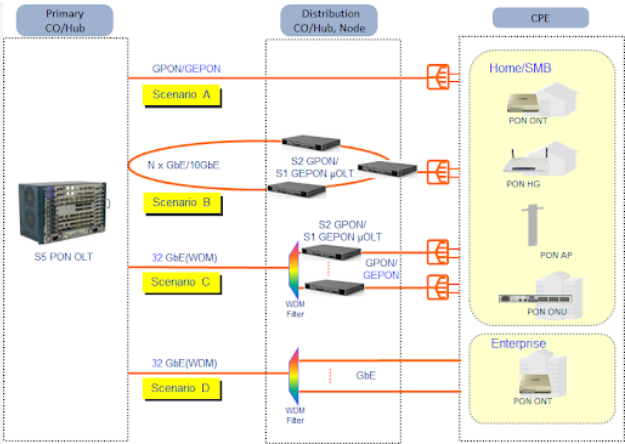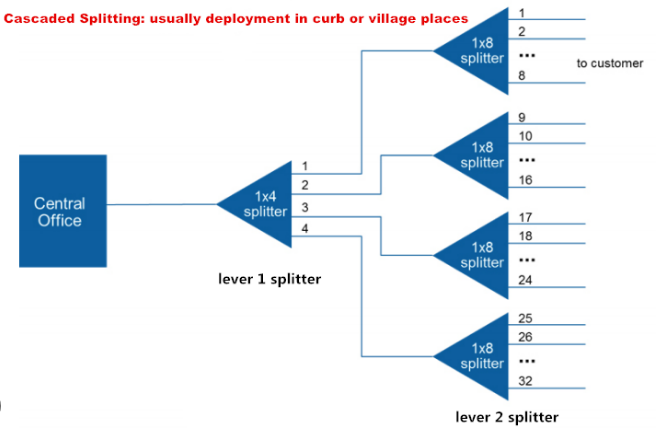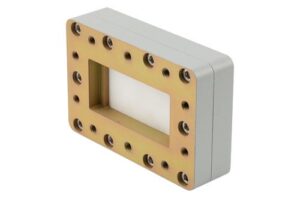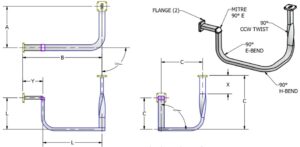Purpose and Placement
S1 and S2 are essential elements in the structure of the Fiber to the Home network, and each has a specific role to play in the scheme of delivery of broadband services. S1 – is the segment that connects the central office to an aggregation node within the overall network, which act as the backbone for the spread of the network. Depending on the area S1 can be fixed at several kilometers, as the segment covers the area between the company’s central office and several dozen kilometers in the area coverage of broadband services provided by the company. S1 is very important because it covers the part of the service in more than thousands of pieces, which means the need for their aggregation.
For example, in a city central office and housing is located from the center of the 20 km, S1 will deliver the digital signal to that point in the absence of signal quality. S2 is a part of the network will not be large and connect the aggregation and the client’s home, and serves to deliver customers to digital services. Thus, in the case of large-scale distribution of the city, S2 will be 2-5 km and reach a few hundred homes, provided that the distances between them will not be crucial, and the number of subscribers will not be over 900 numbers, as the fiber has passed. The last part of this network must be quite robust and effective, because the customer might not experience the effect of the delivery of quality service.
Thus, the difference between the distances covered by the S1 and S2 will determine the nature of the necessary technology for investment in each segment. Thus, for example, if investment in fiber and high-tech realization of S1 can be called for because of the long distance and the overall amount of data for this segment, the S2 invest in more modest means and require a lower density network number. This segment is widely passively divided impact fiber-optic signal of many users joining together. Thus, the optical splitter splits the optical signal between multiple sets of end users. The price of all this is relatively low and rather supplied with last subscriber.

Fiber Type
S1 and S2 segments in Fiber to the Home networks heavily rely on the use of single-mode fiber, which has been modified for exceptional performance at various distances. Single-mode fiber is characterized by a very small core size (8 to 10 micrometers in diameter), which can transmit infrared laser light . The small size of the core minimizes signal attenuation, which, in turn, means that the cable can be used for longer distances, such as in S1. The ability of single-mode fiber to transport signals across several tens of kilometers without a major loss is invaluable, especially in rural or sprawling suburban environments where the central office may be a considerable distance away from the subscriber’s home.
For example, in a regular urban deployment centre, the S1 path may be stretched out to a distance of around 20 kilometers. Single-mode fiber, as one might surmise, can easily handle this task with negligible losses in the signal, maintaining a relatively high bandwidth capacity of around 10 Gbps or more. The importance of this type of fiber is further emphasized by the need to backhaul in large amounts of data from a whole neighborhood, district, or even a city to the central office. Although S2 also usually incorporates the use of single-mode fiber, the differences in the distances involved are striking; where S1 requires the use of said cable to transfer the data across tens of kilometers, S2, in turn, may span less than 5 kilometers or even significantly less.
Other than preserve the signal integrity, the role of the fiber in the S2 segment is to deliver the data to several users adequately. Since in each case at a vertical split, where one fiber signal also has to supply an individual premise, integrity of the signal is critical for service quality. Also, the technology typically deployed in the segment in question allows to perform several splits on a single cable at a ratio of 1:32 or 1:64, which is to say, split the fiber signal between several hundred homes. Any of the splits, in turn, lead to a small loss, which ranges around 3.5 dB, and, naturally, must be considered during the network’s design to avoid excessive loads on the system. The type of fiber and splitting ratio has to be chosen effectively, keeping costs, performance, and network scalability in mind.
The use of single-mode compound can sometimes raise the immediate costs of the investment, due to the increased performance specifications and later maintenance requirements, which are the key factors that should be kept in mind when planning for the network’s development, though in the long run, the lower long-term costs may offset the initial financial burden. Needless to say, to arrive at an effective planning decision, all these variables must be weighed against the community’s present and future needs and ensure that the decision does not cause a drop in data volume and speed.
Signal Distribution
In fiber to the home networks, both S1 and S2 segments play a crucial role in ensuring that the signal reaches the end customers and does so while maintaining its quality and integrity. The S1 segment serves as the primary medium through which the signal is delivered from the central office/distribution node to the nearest aggregation node. High volumes of traffic are carried through the fiber optic backbone, which serves multiple distribution points. This traffic includes data, video, and voice signal, all of which are necessary and, in the case of such a high volume of data, must be transmitted without excessive signal loss.
Overall, its design is meant to waste as little time and materials as possible on data transfer; given that the signal is run at such great length, a fiber optic line with high capacity is the only means capable of transferring such a high data volume at all, and it must support capacity substantially higher than 40 Gbps, so as to aggregate the signal coming from thousands of subscribers at the same time. Indeed, this segment is only possible in a metropolitan area, since rural areas would not have an aggregation node within 30 kilometers or so, and this is the approximate maximum length which the signal can traverse without degradation and without optical repeaters that would introduce too high of an energy loss within the network.
The role of the S2 segment is to disaggregate the signal and deliver it to individual customers. Technologies such as optical splitters can evenly divide the signal into packets and distribute it among subscribing parties. This is the key to its design, since a single fiber line from the S1 segment can serve hundreds, thousands of homes. Of course, each splitter does degrade the signal by 3.5dB and, thus, loses 70% of its power, but this allows the signal to be extended countless times without powered repeaters, which adds to the energy costs and increases the environmental footprint of the whole network.
In a more practical light, it also must prepare for the various possibilities of extending the network in the further future. For instance, a certain suburban development might further develop and densify, thus adding homes and potential prospective clients. As their number grows, the engineers must ensure that they can install additional splitters or run fiber optic cables into hitherto unused portions of territory, while in any case, keeping the signal strong enough to support high definition video streaming, telecommuting, and online gaming, as is expected in today’s digital household.

Capacity and Scalability
The S1 and S2 segments of Fiber to the Home networks are crucial for realizing the desired high capacity and scalability, which are becoming increasingly important as data demands rise. S1, which connects the central office where the services are processed and offered to the users to the aggregation nodes, is required to transport huge data volumes. With bandwidths that might reach beyond 100 Gbps, the S1 segment is used for servicing several hundreds or thousands of users of high-volume traffic such as streaming, gaming, software downloading, or big data analysis.
Therefore, the size of the S1 segment considerably influences the entire system’s characteristics. In particularly, if the network in question constitutes the only viable method of internet access, as is the case with many urban networks, it will be responsible for the transmission of most, if not all, of the data generated in the region. Accordingly, the S1 segment will serve not just the residential users but also the data flows of commerce and industry and become an important feature of not just the local but also the regional connectivity.
In contrast, S2, which runs from the aggregation nodes to the individual subscribers, must be scalable to support the entire number of users. The S2 segment is typically designed to be easily adjusted based on the total number of subscribers and their total traffic. For instance, with a splitter, the optical signal might be divided close to the user’s destination, and the lightweight signal might be routed up to 64 times based on the quality and strength of the optical signal required at the subscriber’s premise. Crucially, it is important for both the fiber and the devices used to be upgraded, as they must be ready to support future expansion of the bandwidth for the FTTH system.
As such, for instance, in an FTTH system that is established with the aim of offering 1 Gbps to each subscriber, it will be possible to transition to up to 10 Gbps with no additional construction or installation of new fibers but the simple installation of a new optical network unit at the subscriber’s premises. Meanwhile, selection of components and planning of installation also takes into account medium-term considerations of at least half a decade or longer.
For instance, if a region is selected for anticipated high density of new development of residential or industrial facilities, additional conduits for optical signal transport may be put in place, and underground dark fibers that are not in use also be placed into them. In such an approach, which has the relatively lower costs of land development than fiber installation that requires major underground trench work and other kinds of construction, network expansion is considerably simplified.
Maintenance and Accessibility
Ensuring and maintaining accessibility of the S1 and S2 segments of Fiber to the Home networks is essential for uninterrupted, high-quality service provision. The S1 segment, which is located between the central office and the aggregation nodes, is usually much more extended and may physically span urban, suburban and even rural areas. As such, it is more rare and more costly to maintain since the providers have to monitor it for possible fiber cuts or degradations that can cause many users to lose access to the network.
To this end, the maintenance team in the S1 segment usually uses more advanced diagnostic tools, such as Optical Time Domain Reflectometers that can pinpoint exactly the segment of the cable that is at fault. Moreover, because such fiber reflectometers can detect even slight losses of signal, maintenance can sometimes help prevent fiber degradation if the problem is spotted in advance.
However, because of the physical sizes and importance of the S1 segment, the cost of its maintenance is especially considerable. An example of such cost can be the fact that a single cut in the primary route of fibers in S1 may cause a loss of connectivity for a thousand or more subscribers, including residential users and small businesses or critical services, such as emergency calls, that rely on the network.
The S2 segment, in contrast, is more local and more accessible from the perspective of maintenance. IT starts at the aggregation nodes and extends to the subscribers’ premises, meaning that the size of S2 is usually much smaller than for S1. For this reason, maintenance is also more frequent provider-side: the deeper the network reaches into residential areas, the more likely it is to sustain physical damage from construction, weather and other conditions.
Moreover, once the S2 team needs to access service poles, conduits underground or the communications closets within the buildings, the cost of maintenance becomes considerable as well, even though it might be lower per incident than for S1. Overall, maintenance of both S1 and S2 poses a significant operational cost for the service provider, who must consider the intricacies of maintaining such large and costly networks in a non-disruptive manner.
For this reason, providers often use systems that physically incorporate both S1 and S2 segments, allowing for constant, real-time monitoring of the entire network. Such systems allow maintenance to be more scheduled and less reactive, and they provide comprehensive insights into the functioning of the systems.
Technological Requirements
Considering the S1 and S2 segments of Fiber to the Home technologies, the technological requirements involve specific hardware and software to ensure efficient, reliable service delivery. For the S1 segment, which connects the central office to the aggregation nodes, it involves powerful, long-haul fiber optic cables, which are used to maintain signal integrity over large distances. The most commonly used technology in the segment is dense wavelength division multiplexing systems, which enable multiple wavelengths to be sent on the same fiber.
As such, the data capacity is greatly increased, and, as a result, such system as the DWDM can support up to 80 channels on one fiber. Each channel can contain up to 10 Gbps data, resulting in up to 800 Gbps of total capacity. Therefore, the amplifiers are needed in the S1 segment to increase the optical signal over the distances which can exceed 50 km without the need in regeneration. The loss of data in this part of the network ensures that the data is reliably sent to various parts of the city, region, or other location.. It is essential for S1 to have robust technologies as it has the most wide and ranging application across the most vast distances.
As for the S2 segment, the technology is fitting for distribution rather than distance. Here, the passive optical networks technology is used, which does not need the electrical power to send the data through the lines. The PON systems are divided into 2 parts, which include the central office, also called as the optical line termination, and the optical network units at the customer’s end. The PON requires a splitter in order to divide the light from the main line into no more than 64 different end users of customers. Such technology is very efficient in terms of power, as it requires a minimal amount of energy to flow the connections and in terms of usage, as there is no necessity in many active components to be set up, amended, and regularly updated at the customers’ end.
The power, therefore, is split, after which the splitting of power is made at each succeeding level of the splitting meter. Perhaps most important are the optical network units on the customer’s side, which divide the optical signal into the electrical signal used by the different appliances including a household computer, smartphone, or television. Not only are there massive amounts of data to be stored, but they also must be danced at incredibly high rates because of such modern applications as high-definition video streaming, extensive gaming over the internet, and the uploading and downloading of massive amounts of data.
It is also important for both S1 and S2 to have a reliable network management system to monitor the network’s performance and solve operational problem immediately to effectively direct the flow of traffic across the network, as well as to manage the allocation of bandwidth and the reliability of the service. All in all, the ability to support detect and fix problems from a remote location is essential for a maintaining a reliable high quality of service.







